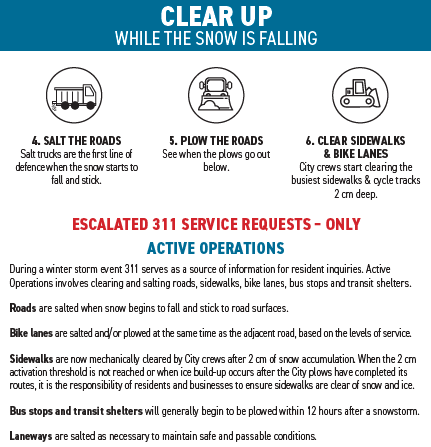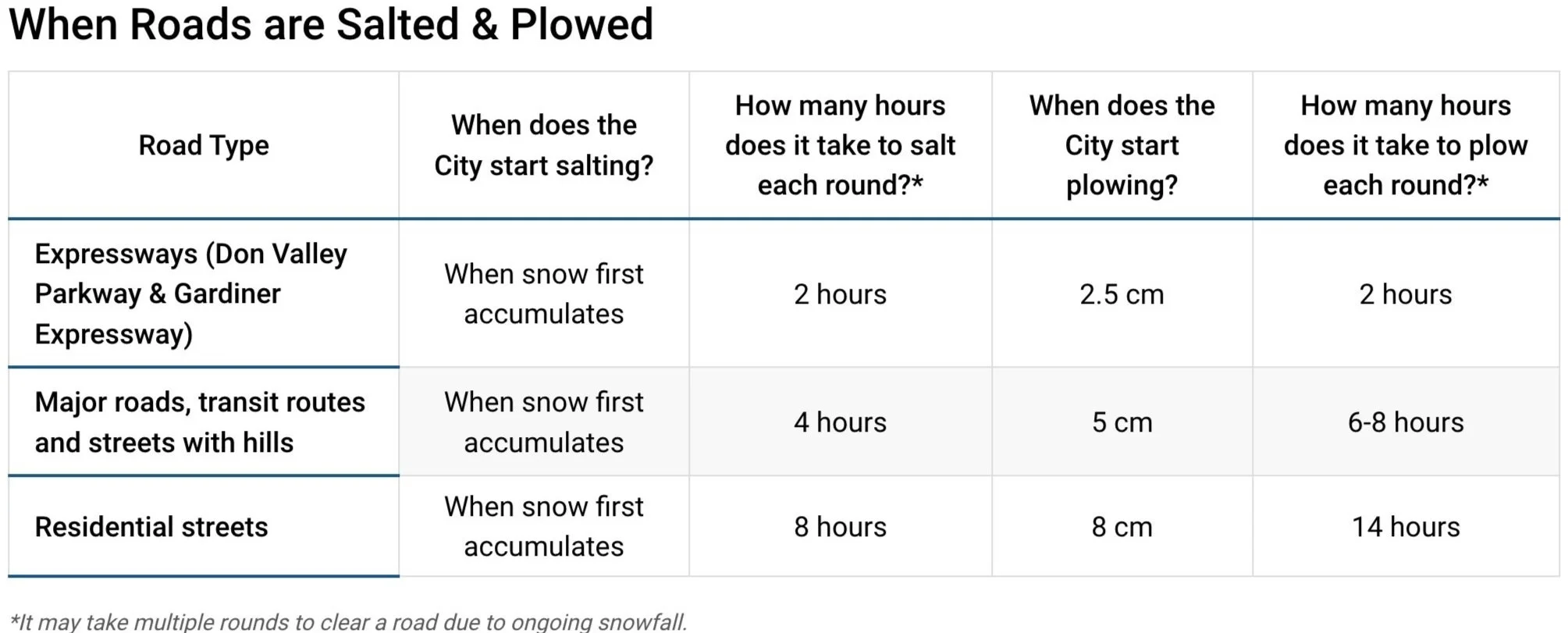Significant Weather Event – What You Need to Know
Winter Operations
Maintenance and Utilities
Snow Clearing in Parks
Winter maintenance of park pathways, trails and roads is provided at more than 250 parks across Toronto.
Pathways are cleared of snow within 24 hours if there is more than 8cm of snowfall
Paved recreational trails are cleared of snow after 48 hours
Salting occurs within 24 to 48 hours of snow clearing
Maintenance may vary depending on local and environmental conditions. The City cannot maintain all pathways in all parks during the winter due to factors such as pathway/trail surface material and whether the pathway is located within Environmentally Significant Areas.
Visit the map today to find out what roads and sidewalks near you were recently salted and plowed and where the vehicles are now.
Salting & Plowing Roads
Toronto’s 14,700 km of road lanes, 7,900 km of sidewalks and 486 lane-km of cycle tracks (including separated bike lanes, on-road bike lanes and multi-use trails) is cleared by a fleet of approximately 1,400 pieces of snow clearing equipment.
24-hour patrols continuously check road conditions and staff monitor weather forecasts and pavement temperature. Even before the snow starts to fall, crews swing into action and work continuously until the storm is over.
Sidewalk Clearing
Clearing ice and snow from the sidewalk in front of/adjacent to your home, private property or business helps keep neighbours and communities safer for everyone when it snows.
When Residents & Businesses Clear Sidewalks
If snowfall accumulation is 2 cm or less in depth, it is up to residents and businesses to clear their sidewalks of snow and ice within 12 hours of the end of a snowfall.
Property owners are responsible for clearing ice and snow from private property – including driveways, parking spaces, steps, ramps and landings – within 24 hours after snowfall ends to provide safe access for people and vehicles.
You can contact 311 to report a property owner who did not clear their sidewalk or private property.
Please be a good neighbour and help clear sidewalks for senior or disabled persons nearby.
Clearing Catch Basins
Where safe to do so, residents are asked to clear catch basins (the square grates on the road) in front of or near their homes of ice, snow and debris to help prevent surface flooding and allow water to drain off the road.
When the City Clears Sidewalks
City crews start clearing all public sidewalks when the snow is 2 cm deep and the snow has stopped falling, or when icy conditions dictate.
Sidewalk clearing after a snowfall takes approximately 12 hours to complete and, depending on the storm severity, may occur more than once. Sidewalk clearing can continue up to 72 hours after the snow has stopped falling.
98 per cent of all sidewalks in Toronto receive mechanical sidewalk snow clearing. Due to sidewalk obstructions and narrow spaces, the remaining sidewalks are manually cleared by workers.
Driveway Windrow Openings
Residential Streets
Using a specialized machine that follows the snow plows, crews will clear three meter wide driveway openings on eligible residential streets.
Collector and Arterial Roads
Using a specialized machine that follows the snow plows, crews will clear three meter wide driveway openings on eligible collector and arterial roads if the windrow (snow pile) exceeds 25 centimeters.
Timeline
We aim to clear three meter wide driveway windrows within two hours of road plowing. However, the time needed to complete windrow clearing depends on a variety of factors such as the size of the plow driver’s route, the amount of snow that has accumulated, on-street parking and other potential obstructions.
Winter Cycling
Many people in Toronto cycle all year to work, school, for errands or for recreation. Annual counts have shown about 20 per cent of peak summer cycling volumes continue through the winter, which translates to approximately 1,200 people a day cycling on Richmond Street/Adelaide Street, and approximately 1,000 people a day cycling on Bloor Street.
Providing clear and safe bikeways in winter encourages more people to cycle on city streets and trails. With a bit of extra planning, preparation and the right mindset, winter cycling is feasible and enjoyable in the colder months.
All types of cycling infrastructure are cleared when two centimeters of snow accumulates. It takes approximately eight hours for crews to plow each round and it may take multiple rounds of plowing to clear all cycling routes after a snowfall.
Cycle tracks and multi-use paths are plowed using smaller plows that are up to 1.5 meters wide. This equipment is used to clear snow and ice from bikeways with physical barriers or that are raised from the roadway. For two-way bikeways, the snow clearer will make one pass in each direction to ensure both lanes are clear of snow and ice.
City crews monitor conditions to identify problem areas that need additional service. Residents can also help to identify problem areas by contacting 311 and submitting a winter maintenance request of a bikeway or trail. Crews will be dispatched to inspect and clear the area, as required.
If you prefer to leave your bike indoors but still want to experience winter cycling, consider using Bike Share Toronto , which offers access to bikes throughout the city 365 days a year.
Cycling Safety Techniques in Winter Conditions
With a bit of extra preparation, including checking the weather conditions and understanding how to navigate city streets in the winter months, winter cycling can be as enjoyable and rewarding as cycling any other time of the year.
Snow banks may force people cycling further out in a lane. Communicate your intentions by shoulder checking and using hand signals if you need to move out from the curb.
Lights should be used in all seasons 30 minutes before sunset until 30 minutes after sunrise.
Wear a close fitting breathable base layer and waterproof jacket and pants if possible. Be cautious to choose items that will not catch in the chain or other parts of the bicycle.
If you encounter black ice, steer straight, avoid pedaling, and try not to brake as this could cause you to skid and fall.
Leave extra room for braking and shift often to prevent snow from locking the chain.
Plan your route in advance using the Toronto Cycling Map and have an alternative in case of snow or ice.
Salt Management Plan
The Salt Management Plan will ensure that the City stores and uses road salt wisely. The plan includes:
an annual audit of existing salt spreading practices and operations to determine what improvements should be considered
an annual inspection of salt storage facilities at all city yards and camps; many minor deficiencies have already been corrected, and new measures are being proposed
ensuring that salt deliveries are done during non-inclement weather and tarped to protect against spillage and wind
ensuring spreader controls are calibrated and accurate records are kept and how salt is handled at city yards
installation of infrared pavement temperature sensors on additional patrol and supervisory vehicles to assist staff in determining actual road temperature conditions
introduction of a number of new salt spreading trucks with electronic controls to the city’s fleet; future plans call for more new vehicles to replacing ageing trucks with outdated controls
fitting a number of trucks with anti-icing and pre-wetting equipment; anti-icing and pre-wetting trials will be conducted using alternative de-icing products
increased staff training for staff who apply salt to roads
a review of snow disposal sites, addressing where the disposal sites are located and which remediation resources are necessary
installation of five Road Weather Information System units at key locations within the city
these units are local automated weather reporting stations that also use sensors embedded in the roadway to provide continuous information on air and pavement temperatures
this is to help staff in making informed decisions on when to begin using salt on roads and
installation of global positioning units in some trucks in order to conduct a pilot study to track the location of trucks and to record when and where salt has been spread and at what application rate
Winter Washrooms
More than 50 washrooms will remain available in the winter. These washrooms will be open daily from 9 a.m. to 8 p.m. Find an open washroom.
Golf course building washrooms are open Monday to Sunday from 9 a.m. to 5 p.m.
Winter Safety Tips
Health & Recreation
Use a tennis/pickleball court
Ski or snowboard at Earl Bales Ski and Snowboard Centre, typically open from January to March
Drop in to skate at an outdoor artificial ice rink or skating trail. Lessons are also available
Check out the animals at High Park Zoo and Riverdale Farm
Birdwatch at Toronto’s parks, ravines and natural areas
Toboggan in a City park
Borrow skates, helmets or skate aids for free on a first-come, first-serve basis at a Skate Lending Library
Play disc golf
Stroll, snowshoe or cross-country ski (with your own gear) at a golf course snow loop
Donate, trade or get skates at a Skate Exchange





